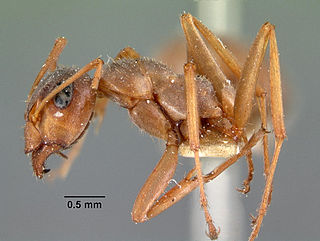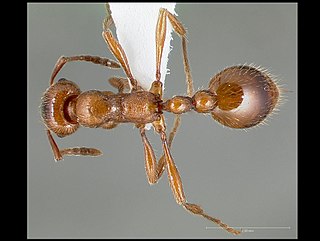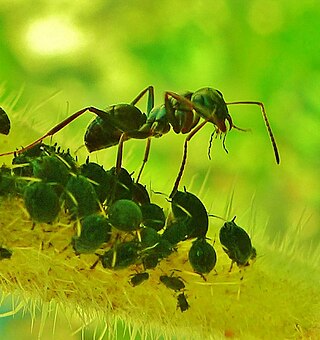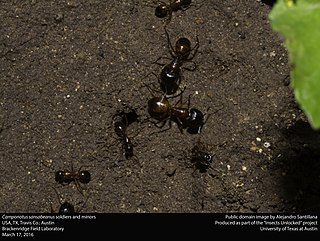Nomada verecunda is a species in the family Apidae, in the order Hymenoptera . Nomada verecunda is found in North America.
Centris cockerelli is a species in the family Apidae, in the order Hymenoptera . The distribution range of Centris cockerelli includes Central America and North America.

Hoplitis anthocopoides is a species in the family Megachilidae, in the order Hymenoptera . The distribution range of Hoplitis anthocopoides includes Africa, Europe, Northern Asia, and North America.

Formica montana is an ant in the genus Formica in the family Formicidae. A common name for F. montana is "prairie mound ant".

Andrena crataegi, the hawthorn miner bee, is a species of miner bee in the family Andrenidae which is in the order Hymenoptera. Another common name for this species is hawthorn andrena. It is found in North America.

Colletes simulans is a species in the family Colletidae, in the order Hymenoptera. The species is known generally as the spine-shouldered cellophane bee. It is found in North America.
Crabro villosus is a species in the order Hymenoptera, in the class Insecta ("insects"). It is found in North America.

Andrena krigiana is a species in the family Andrenidae, in the order Hymenoptera. The species is known generally as the "dwarf-dandelion andrena". It is found in North America.
Stictiella formosa is a species in the order Hymenoptera, in the class Insecta ("insects"). The distribution range of Stictiella formosa includes Central America and North America.

Eremnophila aureonotata, also known as the gold-marked thread-waisted wasp, is a species in the family Sphecidae, in the order Hymenoptera.
Osmia glauca is a species in the genus Osmia, in the family Megachilidae . It is found in North America.

Manica hunteri is a species of ant in the family Formicidae.

Triepeolus is a genus of cuckoo bees in the family Apidae. There are at least 140 described species in Triepeolus. The majority of species whose life history is known are kleptoparasitic in the nests of bees in the tribe Eucerini, especially the genera Melissodes and Svastra.

Ectemnius cephalotes is a species of square-headed wasps in the family Crabronidae. It is found in Europe and Northern Asia as well as North America.

Formica glacialis is a species of ant in the family Formicidae.

Bombus vandykei, the Van Dyke's bumblebee, is a species of bumble bees in the family Apidae. It is found in North America.

Camponotus sansabeanus is a species of carpenter ant native to the western United States, northern Mexico, Missouri, Arkansas, and Louisiana.
Gorytes willcoxi is a species of sand wasp in the family Crabronidae. It is found in North America.
Stelis perpulchra is a species of cuckoo bee in the family Megachilidae. It is found in Central America and North America.
Perdita rivalis is a species of mining bee in the family Andrenidae. It is found in North America.












